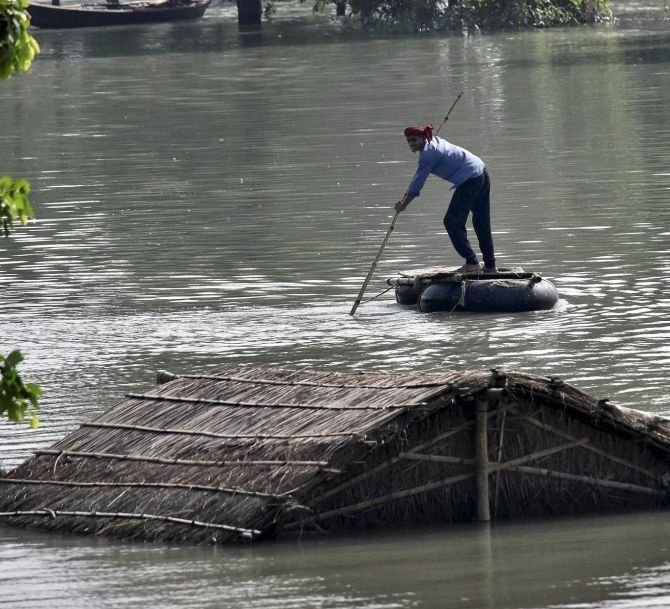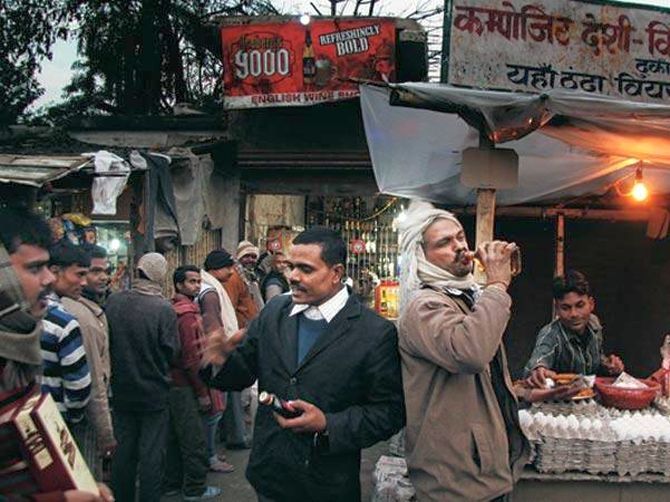
Let Bihar be damned under its contradictions of having gone ‘dry’ and then having been submerged under a flood. After all, it is a godforsaken land, having lost its promise of overcoming its problems, says Mohammad Sajjad.
Paradoxes and ironies seem to abound in Bihar. The Nitish Kumar-led administration, in its previous tenures (2005-13 in coalition with the Bharatiya Janata Party) was criticised heavily for raising revenue from the liquor trade. The revenue went up from Rs 350 crore in 2004-05 to over Rs 3,700 crore in 2014-15.
In the resource-starved state, liquor shops mushroomed across Bihar hinterlands. Further, this arrangement strengthened the liquor dealers’ position. The principal opposition then was the Rashtriya Janata Dal which was critical of the policy.
In the incumbent tenure of Nitish-led administration in Bihar (since 2015), the RJD is the dominant (and aggressive/hegemonic too) ally.
One of the important (and by now controversial, too) steps taken by this regime is to ban liquor. The Bihar government had the banned sale and consumption of country and spiced liquor in rural areas. but had allowed the sale of Indian Made Foreign Liquor in towns and cities. Subsequently, even this selective exemption was done away with. The Bihar Excise (Amendment) Act has restricted the manufacture, transport, sale and consumption of liquor in Bihar and with effective implementation the state was declared dry.
However, what is turning out to be too irksome is the penal provisions in the act which are stringent, as there is a large fine as well as a large jail sentence for anyone caught violating the law. Even more criticism is due for the provisions to penalise even the members of the family and neighbourhood.
Notwithstanding the initial misgivings and outcry, it was claimed by the officials like Patna Divisional Commissioner Anand Kishore that prohibition as well as proactive policing have contributed to a decrease in crime rates in Bihar. The total crime rate in Bihar has reduced by 27 per cent in April. Crimes such as murder, rape, domestic violence, atrocities against the Scheduled Castes and Scheduled Tribes and riots have reduced, and that that the number of road accidents have also reduced since the ban.
Further, the National Family Health Survey report claimed that the ban and its strict enforcement brought a positive impact upon the lives of the women in Bihar; that as many as 46 per cent of women were facing violence after their partner consumed alcohol; that the drunken husbands used to beat up their wives after coming back from work in the evening. The money which was used for consuming alcohol now reached the hands of the wives who could use it to support their child’s education or provide them food and clothing.
The rural women, particularly from poor and lower middle class backgrounds, are said to be still happy with this ban, and they didn’t take it as a draconian one, so long as excessive intrusion by ban enforcement agencies was not there. Now, this is increasingly becoming problematic even for those segments that were quite happy with the ban. This is where the Nitish regime needs to realise that the draconian aspects of the liquor ban laws should be dropped, sooner than later.

This contradictory and divided response in our times asks us to revisit the history of the non-cooperation movement in Bihar, 1920-22. One of the most rigorous of the recent researches on Bihar is by Lata Singh (2009), Popular Translations of Nationalism: Bihar, 1920-22, which demonstrates that ‘there was a strong protest in Bihar’, despite the fact that the ‘liquor boycott was not a part of the official programme of the Congress when the non-cooperation movement started, but once this programme gained momentum, the Congress encouraged it….the brunt of taxation of drink was borne by the lower classes’.
Her evidence further elaborates that this specific issue of liquor boycott enjoyed the support of even those segments of the Indian population who were otherwise opposed to the non-cooperation movement. ‘The liquor dealers were emerging as the great landowners. Most of the poor peasants’ and tribals’ lands were passing to them. Moreover, as the liquor dealers’ estates became larger, they became more rapacious. They maintained their own strongmen to coerce the poor and landless into labouring in their fields for minimal payment. Any protest by the peasants was suppressed with the help of the local police’. The nationalists, while appealing for prohibition, put forward the argument that drinking was a vice and the government had no right to derive revenue from it.
Almost a century later, this narrative of colonial Bihar can be quite instructive for our times. The liquor dealers of 2005-15 minted money and observers say how this segment emerged as the major support base of the BJP in the 2014 elections. Part of the reason for the outrage against the liquor ban laws is this. The responsible sections of media need to take this significant aspect into account, as much as the Nitish regime would be well-advised to review the draconian aspects of the legislation.
Even while the media was articulating the state of affairs in Bihar as ‘dry’, this wretched state is now reeling under the recurrent catastrophe of river-flood, even while the rainfall is 15 per cent less than the usual. However, the larger section of the media is not shouting as much against this recurrence of flood and persistence of neglect by successive Union governments. Even the traditional ruling elites of Bihar, most of who were first with the Congress, and are now with the BJP, preferred to protest least on this aspect.
Thus, till date, Bihar continues to be India’s ‘internal colony’, as coined by the great socialist thinker Sachidanand Sinha, who is in his 90s and lives in his ancestral village in Muzaffarpur.
The magnitude of the flood impact can be gauged by the fact that the flood-prone area in Bihar went up to 68 lakh hectares in 1994 from 25 lakh hectares in 1954. In November 1937, the then minister Syed Mahmood (1889-1971), in the provincial ministry of the Congress in Bihar, had convened a conference in Patna to discuss the flood problems of Bihar. This probably was the first initiative of a popular provincial government in the state. The governor, Hallet, in his inaugural address discussed the flood problems of Bihar only to downplay the enormity of the problem and said that the problem was not that acute as has been made out to be.
Eventually, Syed Mahmood also authored a book, A Plan of Provincial Reconstruction [of Bihar, 1939]. With a foreword by Rajendra Prasad, this book ran into many editions. Now this valuable book is scarcely available beyond the Khuda Bakhsh Library of Patna, which is suggestive of our concern about Bihar’s economic facelift.
A noted flood expert on Bihar, Dinesh Kumar Mishra’s interventions and research publications remain as much neglected by the policy elites as they always have been. Another scholar, Praveen Singh, argues that the “colonial dispensation in north Bihar believed that the rivers of the flood plains needed to be controlled. The zamindar became the pivot around which the implementation of these flood control efforts revolved. Along with the railways and roads, the uncontrolled manner in which many zamindary embankments were built led to deterioration in the flood situation.
"By the 1930s, there was a strong view among engineers that rivers should not be controlled and embankments should be removed wherever possible. However, in contrast to the new official technical doctrine on flood control, a slew of powerful social and economic interests argued for retaining the ‘protected areas’ through embankments”.
Shockingly, despite these adverse experiences, the post-Independence regime in Bihar went ahead with the same kind of embankment policy. Why? Understandably, to let the elites make money, through corruption, from these gigantic projects, so much so that till the 1980s, even the low-ranking employees such as the ‘overseers’ (subsequently called with a rather more ‘dignified’ designation of junior engineers) in the irrigation departments of the Bihar government were counted among the richest government employees, not to say of the contractors who became money-bags of the politicians, preferably of their own castes.
Many of these hegemons went on to become legislators themselves. These ‘wise-men’ of yesteryear came out with the congenitally flawed scheme of making canals the basin of which were lower than the fields to be irrigated. Thus, these canals, in many cases, hardly served the purpose, except filling in the coffers of the politician-engineer-contractor nexus.
What about the academic researches addressing these issues? Well, the universities were busy ‘taking over’ the colleges founded by the landlord politicians who recruited only their caste-men on teaching and non-teaching positions, before handing these colleges over to the government. This was an arrangement wherein there was the practice of almost cent per cent reservation of jobs for the specific caste. These very beneficiaries later scornfully, disdainfully and vehemently critiqued the Mandal Commission on the plea that it was implemented at the altar of meritocracy.
Notwithstanding the adverse impacts of embankment projects, why did the Union government not fund dams which may have provided with hydro-electricity, engendering industrialisation in Bihar along the Nepal border, besides irrigation facilities to the peasantry? One guess could be that unlike the Narmada dam projects in Gujarat, in Bihar the displacements brought about by the dams, could have been wreaked upon the upper caste elites too. And unlike the tribals, these elites are not expendable human beings, to be subjected to forced displacements.
Given the transformation in the character of the media in our times, therefore, we can hardly expect that there would be loud-voiced prime time discussions on television news channels with development experts on the panel. The common people pretending to be educated and informed ones have greater passions reserved for cow protection, ghar wapsi and love jihad.
In such cynical times, who has got the time to think about Bihar's flood devastation!
Let Bihar be damned under its contradictions of having gone ‘dry’ and then having been submerged under a flood, which is a recurrent phenomena. After all it is a godforsaken land, having lost its promise of overcoming its problems, isn’t it?
Mohammad Sajjad teaches Modern Indian History at the Aligarh Muslim University, and has published two books: Muslim Politics in Bihar: Changing Contours (Routledge, 2014) and Contesting Colonialism & Separatism: Muzaffarpur (Primus 2014).










